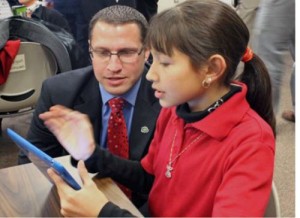Taxpayers to fund up to $80M for technology at district with 14,000 students

A COMPUTER FOR EVERY KID: Santa Fe Public Schools Superintendent Joel Boyd (left) says a $55 million, five-year investment in technology is a tool to help students compete in the 21st century. Santa Fe Public Schools photo.
By Rob Nikolewski │ New Mexico Watchdog
SANTA FE, N.M. — Taxpayers in New Mexico’s capital city have spent plenty in recent years for improved technology and computers for the Santa Fe Public Schools system.
Now they’re about to pay a lot more.
“While we were doing a lot and there was a lot of investment, it certainly was not meeting the needs of our youngsters and it wasn’t enough to meet the needs of our teachers in the classroom,” Santa Fe Public Schools Superintendent Joel Boyd told New Mexico Watchdog.
As a result, the Santa Fe board of education recently passed a $55 million Digital Learning Plan that promises to integrate technology for students and teachers, upgrade computer infrastructure and eventually give personal computers to each of the 14,000 students in the district.
Just two years ago, Santa Fe voters approved a bond to provide $12.7 million per year for six years to fund construction and technological enhancements. That comes to $76.2 million. Included in that amount was $2.4 million to buy Apple computers and technology for students in the summer of 2012.
Carl Gruenler, the SFPS chief business officer, told New Mexico Watchdog the majority of the $76.2 million is going to building maintenance, and “approximately 25-33 percent has been spent for technology infrastructure and equipment since 2012.”
So what happened to the $2.4 million for Apple computers?
Gruenler said that went to replacing old computers at the district’s two high schools.
The just-passed $55 million Digital Learning Plan will be spread out over five years and the school board has approved the first $11 million to be released this school year.
All told, the total price tag for technology related items (infrastructure, upgrades, computers, support, software for all 34 schools in the mix, etc.) may reach as high as $80 million over the next six years.
That’s an awful lot of money for a district with 14,000 students.
Boyd said the Digital Learning Plan is necessary after hearing complaints from teachers of “slow systems, slow start-ups and inadequate services for technology for 21st century learning for kids … In order to do what our children need, that’s what it costs.”
School board member Steven Carrillo defends the plan, which passed in February.
“I think it’s not only good, it’s essential if we’re going to provide technology for our children that most school districts have throughout the country,” Carrillo said.
“That’s the biggest first piece — getting our infrastructure into the 21st century,” Carrillo said. “I’m not kidding when I say (the current system is) back there in the 1990s. That’s not an exaggeration.”
SFPS officials conducted a large-scale poll of 600 likely Santa Fe voters and Boyd said 70 percent agreed an investment in technology was needed. “That’s overwhelmingly supportive,” he said.
Can giving students free computers lead to better academic outcomes?
“These are tools,” said Boyd, who took over as superintendent in August 2012. “These don’t take the place of teachers or other things that we’re doing … Each generation has different tools that are needed in the classroom and these happen to the be the tools of this generation.”
Neal McCluskey, education analyst at the Cato Institute, a free-market think tank based in Washington, D.C., is more skeptical.
“Any time I’ve looked at it, there doesn’t seem to be much support for the idea that more technology leads to better outcomes,” he said. “I don’t think there’s been anything systematic that says it has.”
But a growing number of school districts, from Maine to Texas to Oregon to California, are making big investments in technology and giving out free computers to students.
The Los Angeles Unified School District planned to distribute iPads to all of its 660,000 students in 2013. The program ended up costing millions of dollars more than expected and, to the district’s embarrassment, a number of tech-savvy students quickly learned how to disable the firewalls and used the computers to access computer games and pornography sites.
One of the local TV stations called it ” the district’s iPad quagmire.”
Boyd said Los Angeles can’t be compared to Santa Fe.
“L.A. Unified is a district of 700,000 kids,” Boyd said. “It’s the second largest city in this country … It’s vastly different.”
In addition, Boyd said the five-year rollout by SFPS will help ensure potential problems can be avoided.
What kinds of computers will Santa Fe students get? Boyd said it will depend on the needs of each school. Ramirez Thomas Elementary is one of the first schools to receive computers. Boyd said students there will receive iPads.
Even before implementation, the Digital Learning Plan received criticism because the $55 million project was not approved as a bond measure by voters.
Instead, a divided school board approved it by using Educational Technology Notes. Passed by voters in 1996 as an amendment to the state constitution, the notes allow school boards to impose a property tax on their own.
The measure passed on a 3-2 vote, with school board members Lorraine Price and Glenn Wikle voting against it.
“I thought it should go to the voters … Just because you can doesn’t mean you should,” said Price, who added that she supports the plan now that it has passed.
“If it was a bond, we would have had to wait two years for the proceeds of the bond (to materialize) and that would have set us further behind,” Carrillo said. “I can say honestly and I’m not exaggerating, I only got three emails — three — from people that did not appreciate that we didn’t go to the voters.”
Contact Rob Nikolewski at rnikolewski@watchdog.org and follow him on Twitter @robnikolewski







